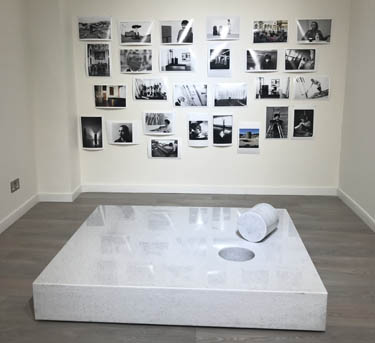Tribute to Mono -Ha at the Cardi Gallery includes seminal works by ten artists, many of the works showing in the United Kingdom for the first time. In addition the exhibition includes archival photographs and videos capturing key moments in the history of the group.
Mono-Ha appeared in response to the unrelenting industrial development of Japan and in particular of Tokyo in the mid 1960s. The label was given to the loose group of artists at a later date by art critics. Though Mono Ha is translated as the School of Things, there is no direct equivalent for the word Mono. It can equally mean thing, matter, material and object. The initial focus of the group was to move away from things as used in minimalist art. The artists responded by ‘not making’ in their search for the essential. The message of the Mono Ha artists was not simply in the works themselves, but in the artists’ desire to root their work in materiality and push back against the supremacy of idea over matter, the artist pointing the viewer to the thought that the material holds the message. Abandoning traditional art materials, the artists focused on easily available materials, both natural and industrial and presented these without undue elaboration.
Susumu Koshimizu
Much of the innovation came from the manner in which they combined and juxtaposed the elements in their work. Lee Ufan, founding member of Mono-Ha and philosopher, refers to this as encounters. The unexpected relationships between materials, between objects and space, between the body and the elements question modernisation and industrialisation at the expense of nature.
Lee Ufan
Paradoxically, the simplicity of the works produced by Mono-Ha artists belonging makes the meaning of the pieces more difficult to decipher. Some like Phase - Mother Earth (1968) came about almost by chance, the development of the work coming from Nobuo Sekine’s desire to work with the materials rather than imposing a plan on them.
‘one can only expose what is there’ (cited Groom, 2001:6)
This work by Nobuo Sekine references his seminal piece Phase – Mother Earth of 1968 in which a large hole (3m deep with a diameter of 2m) was dug. The excavated earth was into a pillar mirroring the hole. The work developed almost by accident, without much conceptual planning.
Nobuo Sekine
This exhibition has encouraged me to reconsider the materials I use in my own work. I frequently use found objects and am naturally attracted to materials such as metal and wood. The yarns I include in my work are usually linen, wool and cotton which I feel best communicate my exploration of our place in the world through skills and objects. I have been challenged to collect objects that I find unattractive rather than the ones I am instinctively drawn to. This has led me to question what and how I chose to work with. Tribute to Mono-Ha has rekindled my interest in aesthetically pleasing materials. The task now is to delve deeper into the why.
Groom, S. (2001) Mono-ha – School of Things. Cambridge: Kettle’s Yard.
https://cardigallery.com/exhibitions/


